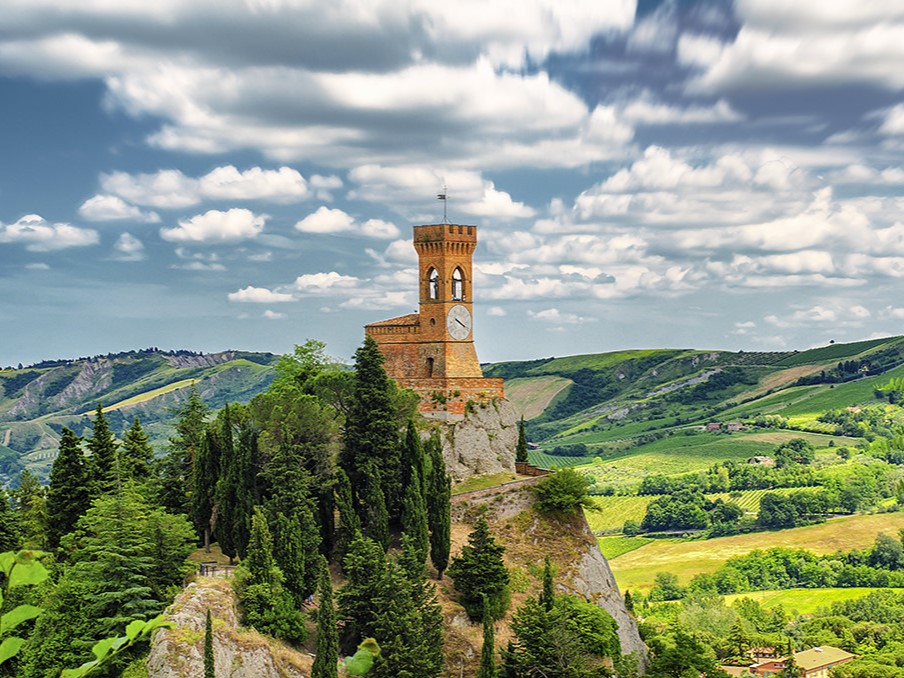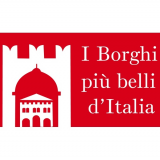
 I borghi più belli d'Italia
I borghi più belli d'Italia
Italian little Italies: Brisighella, In the Hills Amid Fog and Broom
- WTI Magazine #178 Aug 18, 2024
-

 I borghi più belli d'Italia
I borghi più belli d'Italia
The village of Brisighella is set against a chalky hill dominated by three selenite cliffs, upon which the Fortress, the Clock Tower, and the Sanctuary of Monticino stand. On the other side it was defended by two concentric lines of walls which can still be seen in the buildings which have incorporated them.
Inside the historic quarter, the medieval atmosphere is preserved in the rising and falling streets and alleys, the majestic buildings and the low houses, the tiny shaded streets, the hidden corners, and the squares and courtyards that bustle with life on market days and holidays.
The heart of the village, magical in the nighttime quiet, is Piazza Marconi, with Palazzo Maghinardo, the town hall, and the unique Via del Borgo, also called the Via degli Asini (Donkey Street). This is a raised and covered road, illuminated by half-moon-shaped arches of varying sizes, the only one of its kind in the world. Built in the 12th and 13th centuries as a defense bulwark, it was later used by carters for carrying chalk on donkeys from the quarries in the surrounding valley. These carters had "cameroni," i.e. stalls for their animals across from the arches, and their living quarters were on the upper floor. They kept their two-wheeled carts (birocci) in the square down below.
Looming over the village is the Clock Tower, the first bastion of defense, built in 1290. Rebuilt in 1548, it was damaged several times and took its present form in 1850. Today it houses the Time Museum.
Rising on the nearby selenite cliff is the Manfredian Fortress, built to control the Lamone valley. The complex of this fortress includes the Venetian Tower (early 16th cent.) and the 14th-century Torricino, or small tower, built by the Manfredi family of Faenza.
Today, the beautifully restored Fortress stands as an excellent example of medieval military architecture. It is currently the home of the Museum of Rural Life. There is a beautiful view from the bastions of the fortress, as well as from the Sanctuary of Monticino, built in the 18th century on the third hill, once known as Calvary. From here the view takes in the village below and the entire valley, as far as the border with Tuscany.
Inside the village, just outside the old defense walls, there is the Collegiate Church of San Michele Arcangelo, completed in 1697. The façade, recently modified, has a bronze portal, the work of the sculptor Angelo Biancini. Inside there are a 16th-century carved olive wood crucifix and the neo-Baroque polychrome stucco altar dedicated to the Our Lady of Grace, represented in a 15th-century wooden panel. The collegiate church also holds a magnificent Adoration of the Magi, a brilliantly-colored panel by the Forlì painter Marco Palmezzano (16th cent.) originally in the old parish church of Rontana.
At the edge of the village, along the road to Florence, stands the Osservanza, built in 1525 in the name of Santa Maria degli Angeli. Inside there are excellent ceramics and a Pietà by a Brisighella native son, Giuseppe Rosetti, known as Mutino (1864-1939). The church is richly decorated with stuccoes from 1634, and there is a fine panel by Palmezzano above the altar.
Continuing along the road toward Florence we find, just outside the village, the Parish Church of Tho. Its origins go back to the 8th - 10th century. It is dedicated to St. John the Baptist, and it is called "in Ottavo," or "del Tho" for short, because it is located at the eighth mile of the Roman road between Faenza and Tuscany. It is a fascinating Romanesque building having a basilica plan with a nave and side aisles, divided by arches that rest on eleven grey marble columns and one in Verona marble, differing greatly in thickness and width (they could be recycled materials from a pre-existing temple dedicated to the god Jupiter Ammone). A Roman milestone, an 8th-century sandstone altar-front, frescoes from the 14th-15th-16th centuries, and a Corinthian capital (now a holy water stoup) from the 1st century AD bear witness to the complex history of this important place of worship.
The name
In old documents the name is written with various spellings - from Braxeghella to Brissichella, and since 1550, Brisighella - and the name has different interpretations. Some connect it with the Celtic-Lombard root Brix (steep, rugged place); others propose the late Latin Brisca (spongy earth) and still others claim that it derives from Brassica (cabbage), a plant that grew spontaneously in the area in the past.
The product
While the most important product is extra virgin olive oil, which has been granted a European PDO, the area is also known for its cheese aged in chalk caves, Mora Romagnola pork (an ancient native breed of swine) and the Moretto artichoke.
The local dish
A dish fit to serve a cardinal: a sheet of fresh egg pasta is spread with a thin layer of filling ("spoja lorda" in local dialect) made from ricotta, raveggiolo cheese, parmigiano, egg and nutmeg. The pasta is folded back on itself, pressed and cut into squares, then cooked in a beef and chicken broth.